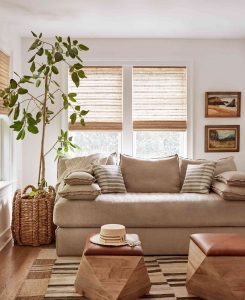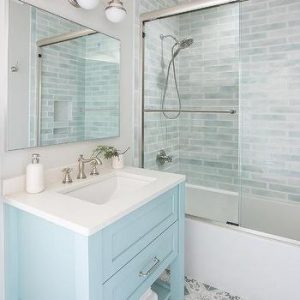Social Links Widget
Click here to edit the Social Media Links settings. This text will not be visible on the front end.
5 Interior Design Choices that Increase Your Home’s Value

When it comes to boosting the value of your home, interior design plays a pivotal role. Thoughtful design choices not only enhance the aesthetic appeal of your living space but also attract potential buyers, potentially increasing the market value of your home. Here are five interior design choices that can significantly enhance your home’s value:
1. Open Floor Plans
An open floor plan creates a sense of spaciousness, making even smaller homes feel larger and more inviting. By removing unnecessary walls and barriers, you can create a seamless flow between the living, dining, and kitchen areas. This modern layout is highly desirable among homebuyers, as it promotes better social interaction and maximizes natural light.
Pro Tip: Consider using consistent flooring materials throughout the open space to further enhance the sense of continuity and openness.
2. Updated Kitchen
The kitchen is often considered the heart of the home, and an updated kitchen can greatly increase your home’s value. Focus on modern, energy-efficient appliances, quality countertops (like granite or quartz), and stylish cabinetry. Even small updates, such as new hardware or a fresh coat of paint on cabinets, can make a big difference.

Pro Tip: Incorporate a functional island with seating to provide additional workspace and a casual dining area, which is a feature many buyers look for.
3. Luxurious Bathrooms
Upgrading bathrooms can provide a high return on investment. Think about installing double vanities, contemporary fixtures, and high-quality materials like marble or porcelain tiles. Adding features such as a walk-in shower or a soaking tub can create a spa-like atmosphere that appeals to buyers looking for a touch of luxury.
Pro Tip: Consider heated floors in the bathroom for an added element of comfort and luxury.
4. Smart Home Technology
Integrating smart home technology can make your home more attractive to tech-savvy buyers. Consider installing smart thermostats, security systems, lighting, and even smart kitchen appliances. These upgrades can make your home more efficient, secure, and convenient.
Pro Tip: Ensure that the technology you choose is user-friendly and compatible with various smart home ecosystems to appeal to a wider range of potential buyers.

Pro Tip: Ensure that the technology you choose is user-friendly and compatible with various smart home ecosystems to appeal to a wider range of potential buyers.
5. Quality Lighting
Good lighting can transform a space, making it feel warm and welcoming. Invest in a mix of ambient, task, and accent lighting to highlight different areas of your home. Modern, energy-efficient LED lighting fixtures are a great choice, and adding dimmer switches can provide flexibility for different moods and occasions.
Pro Tip: Use lighting to highlight architectural features or focal points in your home, such as artwork or a beautiful staircase.
Conclusion
By making these interior design choices, you can significantly increase your home’s value and appeal. Whether you’re planning to sell in the near future or simply want to enjoy a more beautiful and functional living space, these upgrades are worth considering. Remember, the key is to focus on quality, functionality, and timeless appeal to ensure that your investment pays off.

Ready to sell your home? Give us a call! 334-695-9173 or use our home valuation tool at kentmccowngroup.com for a hassle free home valuation!
Transform Your Space: The Power of Color Psychology in Interior Design

Color plays a crucial role in our lives, influencing our emotions, behaviors, and even our perceptions. In the realm of interior design, understanding color psychology can help you create spaces that not only look beautiful but also feel harmonious and serve their intended purposes. Let’s explore how different colors affect mood and ambiance, and provide guidance on choosing the right colors for various rooms in your home.

The Basics of Color Psychology
- Warm Colors: These include reds, oranges, and yellows. They are stimulating, energetic, and can make a space feel cozy and inviting.
- Cool Colors: These include blues, greens, and purples. They tend to have a calming, soothing effect and can make a space feel more spacious and serene.
- Neutral Colors: These include whites, grays, and beiges. They are versatile, timeless, and can serve as a perfect backdrop for other colors.
Choosing Colors for Different Rooms
1. Living Room: Warm and Welcoming 
The living room is a social hub where people gather, so it’s important to create a warm and inviting atmosphere.
Best Colors: Warm shades like soft yellows, warm neutrals, and muted reds or oranges.
Why: These colors can promote conversation and make the space feel cozy and welcoming.
Tips: Combine warm colors with neutral tones to balance the energy and avoid overwhelming the space.
2. Kitchen: Energetic and Fresh
Kitchens are often bustling spaces where people cook, eat, and socialize. Bright, energetic colors can stimulate appetite and activity.
Best Colors: Bright whites, yellows, greens, and even bold reds. 
Why: These colors can make the space feel lively and vibrant, encouraging creativity and social interaction.
Tips: Use bold colors for accents, such as backsplashes or cabinetry, while keeping larger areas in lighter, more neutral tones to avoid overstimulation.
3. Bedroom: Calm and Relaxing
Bedrooms are personal sanctuaries where we rest and recharge. Calming colors are essential to create a peaceful environment.
Best Colors: Soft blues, greens, lavenders, and cool neutrals.
Why: These colors have a soothing effect, promoting relaxation and restful sleep.
Tips: Choose muted shades and avoid overly bright or dark colors that can be jarring or oppressive.
 4. Bathroom: Clean and Tranquil
4. Bathroom: Clean and Tranquil
Bathrooms should feel clean and refreshing. Cool, light colors can enhance the sense of cleanliness and tranquility.
Best Colors: Light blues, soft greens, crisp whites, and pale grays.
Why: These colors evoke a sense of cleanliness and calm, making the bathroom a relaxing retreat.
Tips: Use whites and light colors for fixtures and tiles, adding touches of soft colors in accessories and decor.
5. Home Office: Productive and Focused
A home office should promote concentration and productivity. Balanced, neutral tones with touches of color can create an optimal work environment.
Best Colors: Neutral shades like grays and whites, with accents of blues or greens.
Why: Neutrals provide a professional backdrop, while blue and green accents can enhance focus and reduce stress.
Tips: Avoid overly bright colors that can be distracting. Instead, use calming accents to maintain a balanced atmosphere.
6. Dining Room: Social and Comfortable
Dining rooms are spaces for gathering and enjoying meals together. Warm, inviting colors can enhance the dining experience.
Best Colors: Rich reds, warm neutrals, and earthy tones.
Why: These colors stimulate appetite and conversation, creating a welcoming environment for dining.
Tips: Use warm colors on walls or as accent pieces, combined with neutral furnishings to maintain balance.
Final Thoughts
Understanding color psychology can transform your home into a series of spaces that not only look beautiful but also feel perfectly suited to their functions. By choosing colors that align with the desired mood and purpose of each room, you can create an environment that supports your lifestyle and enhances your well-being. Experiment with different shades, consider the natural light in each room, and don’t be afraid to mix and match to find the perfect palette for your home. Happy decorating!
The Realtor Advantage in a Stress-Free Buying Journey

Buying a home is an exciting milestone, but it can also be a daunting process filled with potential challenges. From negotiating prices to navigating legalities, the journey to homeownership can be overwhelming. However, with the right preparation and support, you can alleviate many of these pain points and make your home-buying experience smoother and more enjoyable. One of the most effective ways to do this is by working with a knowledgeable and experienced Realtor.
Understanding the Common Pain Points in Home Buying
Price Negotiation Negotiating the price of a home can be a tricky affair. The real estate market can fluctuate, sometimes favoring sellers and making it difficult for buyers to make a competitive yet affordable offer. It’s easy to become emotionally attached to a property and overbid, stretching your budget beyond comfortable limits. Additionally, disagreements on the property’s value between the buyer, seller, and appraiser can complicate negotiations.
Financing Issues Securing a mortgage approval is often a stressful step. Factors such as credit scores, income verification, and fluctuating interest rates can impact your ability to secure a loan. Gathering sufficient funds for a down payment can also be challenging, especially if unexpected financial changes arise.
Contingencies and Conditions Home inspections can reveal unforeseen problems that may require renegotiation or even cause the deal to fall through. If the home’s appraised value is lower than the offer, financing issues may arise, necessitating additional out-of-pocket expenses. Furthermore, buyers who need to sell their current home before purchasing a new one face the risk of timing issues and potential delays.
Legal and Documentation Issues Understanding and navigating the legal language in purchase agreements can be daunting. Problems with the property’s title, such as unresolved liens or ownership disputes, can delay or derail the purchase. The sheer amount of paperwork and documentation required can also be overwhelming.
Emotional Stress The pressure to make quick decisions, especially in competitive markets, can lead to anxiety and second-guessing. Fear of missing out on a desirable property can push buyers to make hasty or regrettable decisions.
Communication Challenges Coordinating between real estate agents, lenders, lawyers, inspectors, and other parties can be difficult. Misunderstandings or lack of clear communication can cause delays and frustration.
Market Conditions Entering the market at the wrong time, such as during peak seasons or economic downturns, can affect the availability and price of homes. Limited housing inventory can result in bidding wars and increased competition.
Unexpected Costs Buyers may be surprised by the high costs associated with closing, including fees for inspections, appraisals, legal services, and more. Unanticipated repair or maintenance issues discovered during inspections can add to the overall expense.
Alleviating Home Buying Pain Points
Price Negotiation
- Research and Preparation: Study the local market to understand pricing trends and comparable sales. This knowledge will help you make a competitive and reasonable offer.
- Pre-Approval: Get pre-approved for a mortgage to show sellers you’re a serious and capable buyer, which can strengthen your negotiating position.
- Set a Budget: Establish a clear budget based on your financial situation and stick to it. Avoid getting emotionally attached and overbidding.
Financing Issues
- Improve Credit Score: Work on improving your credit score before applying for a mortgage to secure better terms and rates.
- Compare Lenders: Shop around for the best mortgage rates and terms from different lenders. This can save you money over the life of the loan.
- Financial Cushion: Save more than the minimum down payment to provide a financial cushion for unexpected costs or changes in interest rates.
Contingencies and Conditions
- Hire a Good Inspector: Choose a reputable home inspector to thoroughly assess the property and identify potential issues early.
- Be Prepared to Renegotiate: Be ready to renegotiate or walk away if the inspection reveals significant problems.
- Flexible Contingencies: Consider including flexible contingencies that protect you but still make your offer attractive to sellers, such as shorter inspection periods.
Legal and Documentation Issues
- Consult a Real Estate Attorney: Engage a real estate attorney to review contracts and ensure all legal aspects are covered.
- Title Search: Ensure a thorough title search is conducted to identify any potential issues with the property’s ownership or liens.
Emotional Stress
- Stay Objective: Try to remain as objective as possible and focus on practical considerations rather than emotional attachment.
- Set Priorities: Determine your must-haves and deal-breakers in a property beforehand to streamline decision-making.
Communication Challenges
- Effective Communication: Maintain clear and regular communication with your real estate agent and other involved parties. Ensure everyone is on the same page.
- Experienced Professionals: Work with experienced real estate agents, mortgage brokers, and attorneys who can guide you through the process and handle complex situations.
Market Conditions
- Timing: If possible, try to enter the market during less competitive times. Avoid peak seasons if you can wait.
- Patience: Be patient and wait for the right property and conditions, rather than rushing into a purchase due to market pressure.
Unexpected Costs
- Budget for Extras: Include a buffer in your budget for closing costs, repairs, and other unexpected expenses.
- Home Warranty: Consider purchasing a home warranty to cover potential repairs and maintenance issues in the first year.
The Crucial Role of a Realtor
Amid all these potential challenges, a Realtor can be your greatest ally. Here’s how a Realtor can make your home-buying journey smoother and more enjoyable:
Expert Guidance: Realtors have extensive knowledge of the local market and can provide valuable insights into pricing trends, neighborhood dynamics, and more. They help you make informed decisions based on real-time data and market conditions.
Skilled Negotiation: Realtors are skilled negotiators who can advocate for your best interests. They know how to craft compelling offers and negotiate terms that align with your financial goals.
Streamlined Process: From scheduling inspections to handling paperwork, Realtors manage the many moving parts of the home-buying process. They ensure that all details are attended to, reducing the likelihood of costly mistakes.
Access to Resources: Realtors have a network of trusted professionals, including mortgage brokers, inspectors, and attorneys, who can assist you throughout the transaction. Their connections can help streamline the process and address issues promptly.
Emotional Support: Buying a home is an emotional journey. Realtors provide support, guidance, and reassurance, helping you stay focused and confident through every step of the process.
Conclusion
While buying a home can be challenging, it doesn’t have to be overwhelming. By preparing thoroughly, staying organized, and most importantly, working with an experienced Realtor, you can navigate the complexities of the home-buying process with confidence and ease. Your dream home is within reach, and with the right support, the journey to get there can be a positive and rewarding experience.
So, take a deep breath, enlist the help of a trusted Realtor, and embark on your home-buying adventure with optimism and excitement. Happy house hunting!

 Facebook
Facebook
 X
X
 Pinterest
Pinterest
 Copy Link
Copy Link





